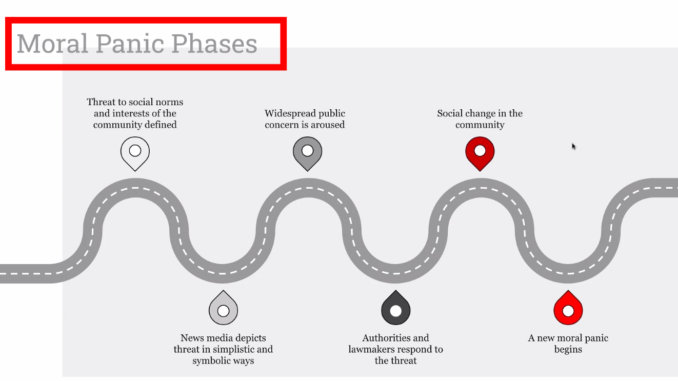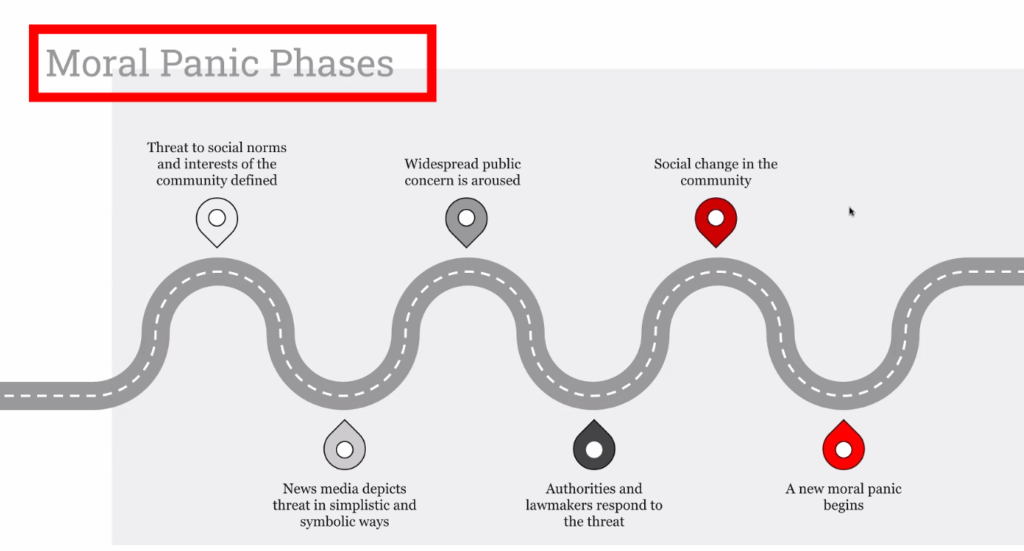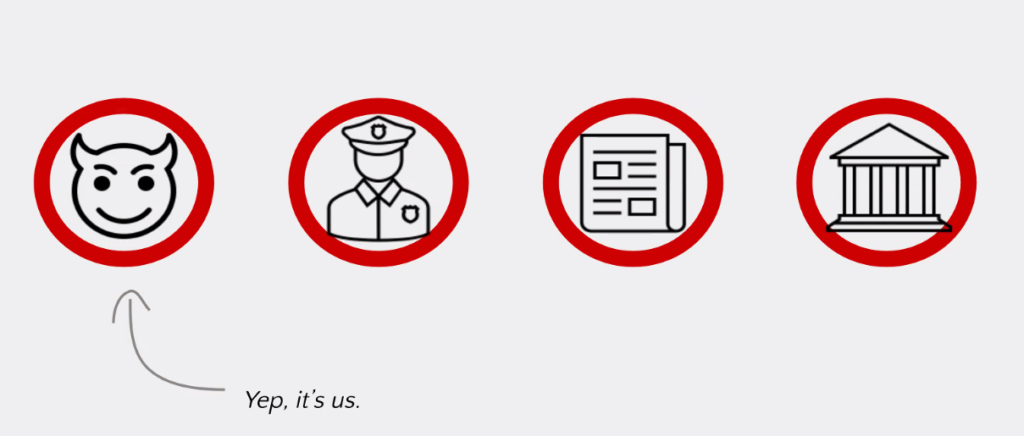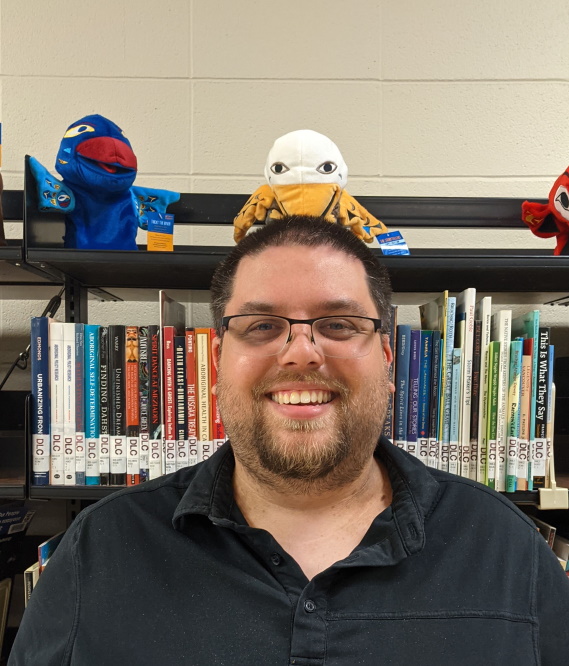
By Joseph Jeffery
In 2018 Canadian Federation of Library Associations/Fédération canadienne des associations de bibliothèques (CFLA-FCAB) held their first national forum as part of the Saskatchewan Library Association conference. Intended as a biennial event to “focus dialogue on some of the most critical challenges facing libraries in Canada” (CFLA-FCAB, 2023) things were put on hold during the pandemic. Now in 2023, as part of the Manitoba Library Association conference, the National Forum returns to address a current critical issue – censorship, intellectual freedom, neutrality, and moral panic.
Leading this discussion through a lecture format was Dr. Lucy Santos Green, Director of Iowa University’s School of Library Information Science. Dr. Santos Green can be found on Twitter at @lucysantosgreen and at her personal site lucysantosgreen.com. The talk was split into two sections, one focusing on defining moral panic, the other on a toolkit to address it. For more information on the toolkit see the companion article here.
Moral Panic
What is moral panic and how does it relate to what we see going on across Canada with book challenges and censorship? To address what it is, Dr. Santos Green pulled back the lens to look first at other areas. These build a framework around which we can better understand where moral panic comes from, what it truly is, and what its real targets are.
Redefining Literacy
Literacy is knowledge, and if knowledge is the root of all evil then perhaps it is where we should start to unpack what is truly happening. Literacy, as we were brought up with the concept, is gone. Even the core idea of literacy that many of us went through teacher training with, that print and digital were distinct, has largely been eradicated. The boundaries have blurred to the point of non-existence, with most students seeing reading, writing, and understanding as the same no matter what the medium. This means that our concepts of separate foundational, media, digital, and information literacies need to change too.
Perhaps then it is time to redefine being literate, not in terms of reading or writing in the traditional sense, nor the digital, but both. Instead, we could define to be literate as to be able to procure, analyze, generate and disseminate information through any medium, any written form, oral form, and even through culture. Furthermore literacy and by extension, being literate, is the ability to engage in participatory identity in the modern, digital realm.
Therefore, Dr. Santos Green argued, literacy and citizenship are really a duality, two interlinked traits and that the changes to literacy as we move more and more into a persistent digital world are radically altering the landscape of our world. This duality threatens existing structures of power, and who has an oversized voice or seat at the table in terms of gatekeeping, in terms of dissemination of information.
In the slide shown in Fig 1. Dr. Santos Green identifies six areas that are being fundamentally altered by these changes to the global concept of literacy and being literate. The term on the left represents where we were, the term on the right where we are headed or where we have reached. Each brings with it challenges and opportunities. Changes that we, as individuals and as society need to grapple with.
Stories are No Longer Static
Stories have long been the structure through which we communicate and share and for a lot of human history they have remained a static idea. Recognizable with things like beginnings, middles and ends, plots, characters, endings. We have now reached a point where there is a new structure emerging. Stories that are non-static. Stories that evolve and change.

Interactive stories where you engage in them, like video games. As Jack Black put it in the latest, as of writing, song from legendary rock duo Tenacious D:
But Red Dead Redemption 2, that is not a game
(Black & Gass, 2023)
It’s an incredible journey through old American history
…
That’s not a game at all, that’s like f****n’ Shakespeare
The depth of these interactive stories is creating something new, stories that each player experiences in their own unique ways; the creators have written out a plot, but the world itself provides endless opportunities to go off in another direction. In this way we are approaching new creative opportunities where narrative cannot be said to be identical for each ‘reader’.
Egalitarian Access to Information
Our resources are also changing; from singular items that only one person could use at a time to more open ideas that allow multiple simultaneous users. While economic and monetary issues still remain, we have entered an unprecedented era of egalitarian access to information. However, with so much information the question, as we know, becomes how do you select what is best from such a wide array.
This move from private resources to more public ones comes with another, much more thorny issue. Who owns the texts you access online? What happens when the content vanishes? Allrecipes.com was a huge repository of recipe information, but when its app was discontinued many lost access to the libraries of recipe they had created and bookmarked. How are we teaching our kids about this ownership piece?
Who Owns Information?
Yet this was just the tip of the iceberg as the world found out this year when ChatGPT and other advanced AI like Google’s Bard were unleashed and opened their own Pandora’s box. When AI interacts with things is it breaching copyright? If I, as a teacher, feed my students’ work into a tool to determine if the work was generated by AI how does that work as an ethical issue? Who owns something created by AI?
All of this is to say, we no longer have the same ownership rights that our parents and grandparents enjoyed. We work for free in private infrastructure creating content for corporations that generates them billions in profit. Even the attempts to create ownable digital content like Non-fungible Tokens (NFTs) were fraught with issues. So another question arises, are you sure you own your ideas? Have you actually read the fine print? What can you pass on to your heirs? Yet these questions don’t stop us, because as humans we are wired to participate, to exchange, to share. This is the ethical conundrum of the new literacy.
As we examine thresholds, the bars for entry, we see the massive changes that have taken place. In the early days of the internet you had to have some level of technological skills, then you needed some level of aesthetic skill. Now the bar to entry has pretty much gone down to “do you have access to a device?”. While still a threshold, this is dramatically different from even ten years ago and it has driven enormous changes. TikTok videos, in their short, punchy format, have become an art form in the way they are put together and edited. So how are we preparing students to interact with this type of information? We can’t ignore it, because they’re not ignoring it. This is what we mean when we say that they don’t differentiate between media types.
With this change has also come the decentralizing of information. Governments, institutions, even libraries are no longer the holders of knowledge. The election in Turkey this week serves as a great example of how even though it emerged they had worked with Twitter to censor the election, the news got out on the very platform they were trying to censor.
Again, this change comes with challenges. With so little barrier to access, the volume of creation has exploded and our ethics as society have not kept up. We know that old tools like the CRAAP test are no longer reasonable (Loertscher, 2022; CIVIX, 2021) and we need to look at alternative means such as lateral reading (CIVIX, 2021) or the STIC model (Loertscher, 2022). Furthermore, with such a volume, from a research standpoint how do we critically analyze things and find reasonable representative samples?
Our feedback loops, particularly our critical ones, have moved from “those you know and have access to” to a global audience. Andy Weir is a prime example of this. Unable to get published in the traditional sense he posted his book online. People said they’d pay for it if he put it up on Kindle. He did and sold 35000 copies in 3 months. He was then picked up by a traditional publisher and given a blockbuster movie. Weir is just one example of many authors who have circumvented traditional publishing either through self-publishing via e-books or through crowdfunding such as Kickstarter. Literacy, now, means that we write for a global audience and interact with people on a global level. People are dying to give feedback, whether you’ve asked for it or not.
The Concept of Memory is Changing
Memory, too, is changing. How many times have we been thankful that we didn’t grow up in the world our students are in as teenagers? This persistent world where everything is documented and nothing is forgotten. It too is part of our new literacy paradigm, because if we are not teaching it, if we are not helping students understand, then how are they going to be able to learn how to grow in a world where their past mistakes can never leave them alone? These are digital tattoos. A good example of this is the filmmaker James Gunn who was fired by Disney after old tweets from a decade prior were uncovered by conservative news media. While he disavowed his old, dark comedy and eventually Disney reinstated him, those actions from when he was in his late teens/early twenties came back to haunt him, even though he could show that he had outgrown that phase of his comedic career. Yet, the world does not seem ready to let anyone forget anything. So how do we respect the process of human growth and change when these digital reminders persist. If we always carry those errors, then we have no way to grow. Therefore, we must make it part of what we teach, that we move on and allow ourselves and others to grow from errors.
Identity as a Facet of Literacy
Finally identity is the last facet of literacy that is evolving. That identity is now part of literacy, that forming who you are and what you think is now something that a literate person needs to be able to do as we become increasingly subsumed by the move towards groups. Technology has evolved faster than our ethics and we have allowed ourselves to become divided and subdivided into increasingly smaller pockets. Some of this is good; we have the ability to not be alone, to find others like us. Yet we also have the ability to be targeted by advertisements, by nefarious other groups, to be set upon one another all too easily. Thus building identity amongst all this is a facet of literacy that we have long taken for granted, but is necessary now.
What all of this describes is the move toward a participatory culture. Dr. Henry Jenkins (2009) defined participatory culture as one where the barrier to artistic expression and civic engagement was low, there was support for creation and sharing of material, and a form of information mentorship that allowed for knowledge to be passed along. For a long time libraries have existed as information silos, the move towards more open participatory models such as library learning commons (Koechlin, Rosenfeld & Loertscher, 2010; Daly, Ekdahl & Zubke, 2017) has solidified our role as information mentors helping to create participatory identity.
The result is our current moral panic.
Moral Panic Phases

Participatory culture reduces barriers significantly that have been in place and institutionalized for generations. It removes power that has been concentrated in the hands of a few and spreads it more evenly. It allows voices to rise that have been silenced or marginalized. This moral panic focusing on libraries and books is not about us, the teacher-librarians, or the books themselves. It is about the people who can now access information, the people whose voices are now allowed to be heard. They are the true target and we are just the vehicle through which the damage is to be done. Moral panic is instituted by the news media, it is perpetuated by politicians, it fosters social control, it focuses on those in the margins – drawing on stereotypes, reinforcing them to exacerbate fear.
Dr. Santos Green then outlined the features of moral panic as:
- Concern–an event that sparks anxiety
- Hostility–a subculture defined as the ‘folk devil’
- Consensus–Fear becomes the dominant narrative in media and in social discussion
- Disproportionality–the perception of the problem vs reality
- Volatility–moral panic comes seemingly from nowhere, exploding overnight. It disappears as quickly when it ends. It may last a long time but the start and end are incredibly quick.
In Fig 2. We can see the phases of moral panic outlined in the presentation. In Canada, as of writing, we are at the third stage where public concern is growing, depending on the news media you interact with and on how these issues are being addressed. Moral panic, as a concept, is never truly over. We lurch from one to another: The War on Drugs, AIDS/HIV Crisis, The Devil’s Music, Immigration, or The War on Terror. The targets change. The idea does not. Why?
- It makes money.
- It allows for the rebalancing of power at the table to ensure continued control.
- It allows for legislation to be enacted that would not be seen as reasonable without the perceived threat at the epicentre.
Who are the Players?

Who are the players in the great game of moral panic? The Folk Devil (right now, us, Librarians) usually a vehicle to hide the true target (LGBTQIA+ people in this instance); The Enforcers, those who would protect you from the awful work of the Folk Devil; The News Media, who attach visual imagery to the Folk Devil, often incorrect, often stereotypical or over the top; The Government, who use moral panic to enact laws. It is important to note that moral panic is not attached to one ideological side or the other. Governments of all stripes do this.
We Are Not Neutral
What do we do then in this age of moral panic? We don’t stay neutral. “May neutrality die, there’s no such thing. No, there is not,” declared Dr. Santos Green. By pretending towards neutrality, by refusing to stand up for books within our collection, we are implicitly choosing a side. Libraries are not neutral spaces. Whenever we advocate for banned books that some find offensive, look to include everyone in our communities, or create pride displays that feature LGBTQ+ authors, we are choosing to step up. Libraries are for everyone and the materials, programs and services we offer must reflect this.
The moment we started down the path of information mentorship and helping our patrons with participatory learning we were headed on the path toward this current moral panic, because we abandoned our role as part of the system of oppression. For a long time libraries were gatekeepers to knowledge. By choosing to embrace participatory culture we began down a path of ‘misbehaving’. Remember though, it isn’t us they’re trying to silence. They’re trying to stop egalitarianism, they’re trying to stop stories being told by people who fall outside of the ones that they want to hear. That’s what is truly happening. The slope back to being part of systemic racism, systemic transphobia and systemic homophobia is easy to slip down. Especially if we begin to self-censor, to preemptively censor ourselves.
We must remember that children and youth are people, that LGBTQIA+, that BIPOC children and youth are people. They have an equal right to be part of participatory culture. This is an uncomfortable time, and it can be an uncomfortable space. For most of us the space of librarianship has been comfortable. It was designed for us. Now we need to confront things, we can’t let that need to return to comfort make us preemptively dive for the escape hatch by stickering things up as mature, or removing them from collections “just in case”.
We have policies. Our policies should be robust and well written and not given to vagaries. The laws being established, or the words being used by those who wish to censor are being done so in vaguely defined ways on purpose. They will use terms like age-appropriateness but refuse to define it properly, committing only to vague, broad strokes definitions that become weaponized as “what the adults want”, not what is actually age-appropriate. We are professionals. We know how to determine what is age appropriate as a profession.
A Call for Inclusive Leadership
Dr. Santos Green ended with a call for national organizations and provincial organizations to become more proactive around inclusive leadership. Not just by setting standards, but by addressing what it would actually look like and how we get there; thinking about who is promoted within the field and why, and what negative leadership looks like. There will need to be serious internal evaluations of ourselves if we want change. It cannot be put on the marginalized to make the change. Yet, she argued, it is not just about recruitment. Retention is the bigger problem because too often people rise only for the system to treat them poorly and when someone fails, it is seen as the whole group failing, when that would never occur within the dominant group.
This ended the first part of the forum. The second part was to look at the Get Ready, Stay Ready toolkit. A separate article on this can be found here.
A huge thank you to Dr. Santos Green for the excellent presentation and for allowing us to use pictures of her slides for this article, and to CFLA-FCAB and the Manitoba Library Association for hosting this national forum around such a timely and important topic.
Nenachalhuya mba hodul’ehne.
We are thankful for your teaching and the learning we have done.
References
Black, J. and Gass, K. (2023). Video Games. YouTube. Retrieved May 17, 2023, from https://www.youtube.com/watch?v=GNJtPFXUnm4
CFLA-FCAB. (2023). CFLA-FCAB National Forum, Register Today!. Retrieved from https://cfla-fcab.ca/en/news/cfla-fcab-national-forum-register-today/
CIVIX. (2021). The digital media literacy gap. Retrieved from https://ctrl-f.ca/en/wp-content/uploads/2022/01/The-Digital-Media-Literacy-Gap.pdf
Daly, H., Ekdahl, M. and S. Zubke, eds. (2017). From school library to library learning commons: A pro-active model of educational change. Retrieved from https://bctladotca.files.wordpress.com/2018/02/from-school-library-to-library-learning-commons.pdf
Jenkins, H. (2009). Confronting the challenges of Participatory Culture: Media Education for the 21st Century. The MIT Press.
Koechlin, C., Rosenfeld, E., and Loertscher, D. V. (2010) Building a learning commons: A guide for school administrators and learning leadership teams–A whole school approach to learning for the future. Salt Lake City, UT: Hi Willow Research and Publishing.
Loertscher, D. (2022). The STIC Model (Six Tests of Information Confidence for the Informed Learner). The Informed Learner – How to Navigate the Sea of Information. Retrieved from https://sites.google.com/view/theinformedlearner/home

Joseph Jeffery is the District Learning Commons Teacher-Librarian for SD57 Prince George, BC. He has been a TL since 2013 at both elementary and high school. He is an immigrant to Canada and is Bangladeshi/English on his mother’s side and Ukrainian/English on his fathers’. He supports teachers and teacher-librarian’s throughout the district in resource selection and acquisitions, e-resources, and all types of literacy. Joseph is the BCTLA’s conference organizer, and a lead writer for CSL’s Collection Diversity Toolkit.